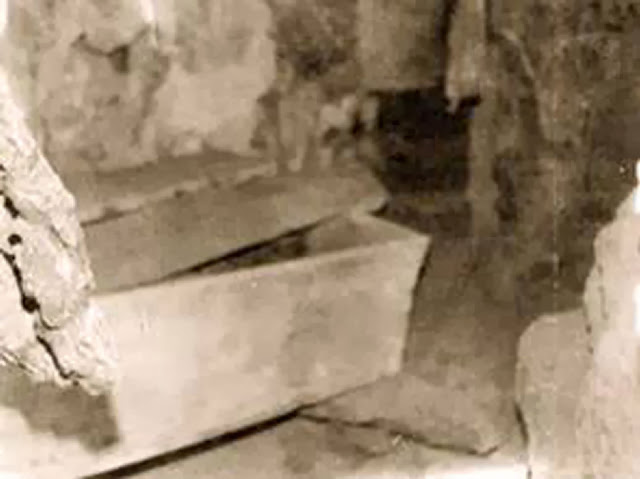
Terminus of the phosphate railway line
In 1904, it’s been confirmed that Makatea contained one
of the purest phosphates deposit in the world. As a result of which, the destiny
of the atoll is going to change drastically.
The first rumors about the
presence of phosphate on the island of Makatea back to 1884. But, Captain
Bonnet was the first who, in 1890, reported the presence of this valuable
fertilizer.
 |
| The village of Temao at Makatea in 1910 |
It
should be expected until 1904 that Professor Agassiz bring back to Papeete samples for analysis. The confirmation of a possible and
valid exploitation of a tricalcite phosphate, grading between 80% and 85% pure
ore, one of the highest of the world, is finally given.
Birth of an extraordinary
industrial adventure
Since 1905, Touzé, a chief of
Public Works, came. In three short years, he will influence things fundamentally.
 |
| The “fare” (home) of the mine manager |
In collaboration with Mr.
Goupil, an influential notary in those days, he immediately contact the
“Pacific Phosphate Company” which operates deposits of Nauru and the Indian
Ocean.
And in 1907, with Goupil
family on the one hand and the “Pacific Nauru Phosphate Corporation” on the
other hand, he creates the “French Society of the Pacific Islands”.
 |
| Before the train, transporting of ore by wheelbarrows |
Last administrative and
legal step, on 4 December 1908, the new “Compagnie Française des phosphates de
l’Océanie (Oceanian Phosphates French Company)”, or CFPO, was born; a Company
with 52 shareholders. Mr. Touzé immediately abandons his official position in
order to head the Company.
Phosphates,
environment and cultural heritage
If respect for the
environmental and archaeological sites is reported in official writings,
unfortunately, archeology, at this time, is still in its infancy and phosphate
mining is a priority. So neither excavations, nor study…
 |
| The burial cave of the Spanish Princess |
Fortunately, the burial
caves of the pre-European times often were beyond reach. Thus most of them
escape destruction. In 1930, eight marae
were identified. Only one, “Ra Inpu”, is preserved.
As for the numerous caves
containing clear water that could satisfy a sizeable population, they will be
used only at the beginning for refueling the newcomers. Then, the exploitation will
always take priority.
 |
| Fresh and crystalline water of Vairoa cave |
Groundwater will be achieved
in 1933 and they never provide more than 150 m3 water per day. The supply will
therefore by recovery tanks and by sea.
Phosphates: human
and economic outputs for French Polynesia
From the outset, the new
Company faces enormous difficulties to local recruitment. Thus, in 1908, out of
300 people needed, 25 Polynesians only ensure this required industrial work.
Apart from the Vietnamese who
return home in 1946 because of the war, all Asian workers leave Makatea later in
1934. They are replaced by islanders of Cook.
The phosphate years
in Makatea
It will be until 1956 that
nearly 100% of mine employees are Polynesians.
From 1908 to 1966, thousands
of men from all walks of life and all ethnic groups have worked to extract the
Polynesian phosphate, playing a vital role to the economic development of
French Polynesia.
The legendary
train of Makatea
Initially, if mechanical
devices appear, ore continues to be transported by wheelbarrows on wood boards
instead of roads and even bridges, until the treadmills which join the sheds of
CFPO
 |
| At the station of Falaise : the train of Makatea |
It was only much later that
the rail network will be created at Makatea. Extending over a length of 7 km
and drawing a crow’s-foot, it even has a train station with the evocative name of
“Falaise” (Cliff).
It was in 1927 that the
first metal pier was built at the port of Temao. It’s 50 m. long and it extends
the platform beyond the reef to allow the loading of phosphate on the freighters.
 |
| The “grasshopper” of the port of Temao |
Then, between 1953 and 1955, a gigantic mobile gateway, 300m range, “the
grasshopper”, is installed. It can flow directly 550 tons of mineral ore per
hour in the cargo.
Many remains of these
installations are still visible at Makatea.
From the Makatea
phosphate to Moruroa nuclear power
From 1908 to 1966, about 11,
28 million tons of high-quality ore are extracted from the bowels of Makatea.
There were up to 3000 people,
living in Makatea, spread between the villages of Moumu and Vaitapaua.
Makatea, once the
phosphate exhausted…
But the golden age was to
end. In 1962, there are still 2 273 permanent residents on the island. In
1967, there are only 60 people, owners and fishermen.
The Polynesian workers of Makatea
joined their respective islands. With their expertise, know-being, sense of
discipline and their various skills, these workers become a major asset to the
economy of the French Polynesia.
In particular, they
participate in major projects of the all new installations of the Centre
d’Expérimentation du Pacifique (Pacific Experimentation Centre).
 |
| What remains from the loading bridge, today. |
The era of phosphates is
completed, begins the nuclear…
-The photos accompanying this article come from Michel
Fayadat’s Collection and Vahineitaria Silvia’s research. We would like to thank them.
An article
of Julien Gué
Translated from French by Monak
Copyright
Julien Gué. Ask for the author’s agreement before any reproduction of the
text or the images on Internet or traditional press.


Aucun commentaire :
Enregistrer un commentaire
Cet article vous a fait réagir ? Partagez vos réactions ici :